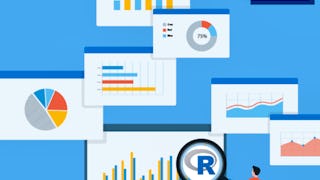What Is Programming? And How To Get Started
January 28, 2025
Article



This course is part of Microsoft Data Visualization Professional Certificate

Instructor: Microsoft
Included with 
Recommended experience
Beginner level
No prior experience is needed. No prerequisites. Following courses in sequence is recommended, as skills and knowledge build on earlier courses.
Recommended experience
Beginner level
No prior experience is needed. No prerequisites. Following courses in sequence is recommended, as skills and knowledge build on earlier courses.

Add to your LinkedIn profile
January 2025
27 assignments






Add this credential to your LinkedIn profile, resume, or CV
Share it on social media and in your performance review


This course provides in-depth knowledge of analytical techniques and effective data visualization using Power BI. By the end of this course, you will be able to:
- Explain different analysis methods (correlation, time series, cluster, etc.) and their appropriate use. - Analyze data through visualizations in Power BI using different analysis methodologies - Leverage AI to explore data and gain insights. Here is a breakdown of what you'll cover: You will begin with statistical analysis fundamentals, master correlation, and exploratory data analysis, and understand business problems. As the course progresses, you will explore advanced topics like cluster analysis, cohort analysis, and geospatial data visualization. Additionally, you will learn about business intelligence concepts, including building time intelligence functions, conducting time series analysis, and leveraging AI-driven tools like key influencers and decomposition trees. With a strong emphasis on practical application, the course culminates in a hands-on final project, allowing you to synthesize your skills in a real-world scenario, making data-driven decision-making clear and impactful. This program is for anyone interested in data analytics and visualization; there are no prerequisites. To get the most out of the learning experience, it is recommended to follow the courses in sequence, as each one builds on the skills and knowledge gained in the previous ones. Before starting this course, you should be proficient in building data models, maintaining relationships in Power BI, and writing DAX expressions to enhance analysis. You should also understand the ethical implications of handling data. This knowledge will be essential as you learn advanced data analysis techniques and explore data through Power BI's visualizations, supported by AI-driven insights.
This module introduces the foundational concepts of statistical analysis in Power BI. You will explore the importance of understanding business problems and how to conduct correlation and exploratory data analyses. The module covers key techniques like grouping, binning data, and using Power BI visualizations to derive insights. By the end, you will have a solid grasp of basic statistical methods and their applications in business contexts.
13 videos17 readings9 assignments
In this module, you will explore advanced statistical techniques, including cluster, cohort, and geospatial analyses. The focus is on applying these methods in Power BI to uncover patterns, trends, and outliers within data. You will also explore the creation and optimization of complex visualizations, such as scatter charts and maps, enhancing your ability to conduct detailed and insightful analyses for informed decision-making.
9 videos8 readings7 assignments
This module focuses on leveraging statistical analysis for business intelligence, with an emphasis on time intelligence functions, time series analysis, and AI-driven insights. You will explore how to use DAX for summarization and comparison over time, as well as how to apply key influencers and decomposition trees to identify root causes in business scenarios. The module equips you with advanced tools to analyze and forecast business data effectively.
12 videos11 readings9 assignments
The final course project synthesizes the skills and knowledge acquired throughout the course. You will apply your expertise to a real-world business scenario, using Power BI to conduct an opportunity analysis. This hands-on project challenges you to demonstrate your ability to integrate various analytical techniques and create impactful data visualizations that drive business insights and decision-making. The module also includes reflection on the course content and guidance on next steps for further learning.
1 video5 readings2 assignments1 plugin



Our goal at Microsoft is to empower every individual and organization on the planet to achieve more. In this next revolution of digital transformation, growth is being driven by technology. Our integrated cloud approach creates an unmatched platform for digital transformation. We address the real-world needs of customers by seamlessly integrating Microsoft 365, Dynamics 365, LinkedIn, GitHub, Microsoft Power Platform, and Azure to unlock business value for every organization—from large enterprises to family-run businesses. The backbone and foundation of this is Azure.

Johns Hopkins University
Course

Macquarie University
Course

Course

Course







Unlimited access to 10,000+ world-class courses, hands-on projects, and job-ready certificate programs - all included in your subscription

Earn a degree from world-class universities - 100% online

Upskill your employees to excel in the digital economy
This Professional Certificate is designed for aspiring junior data scientists who want to kickstart their careers in the business intelligence industry. It is also for current professionals who are seeking a greater understanding of data visualization fundamentals.
This program is for you:
- If you are interested in the field of data analytics and visualization or are just beginning to work in a junior data analyst role.
- If you want to switch or start a career in the field of data analytics and visualization.
- If you already work in data analytics and are seeking a greater understanding of data visualization fundamentals. Earning a Microsoft Data Visualization certificate can help you advance your career or address gaps in your knowledge, skills, and abilities.
This program is for anyone interested in data analytics and visualization; there are no prerequisites. To get the most out of the learning experience, it is recommended to follow the courses in sequence, as each one builds on the skills and knowledge gained in the previous ones.
It typically takes 5 to 6 months to complete the 5 courses. But some learners may go through the content faster.
Data visualization is the graphical representation of data, using visual elements like charts, graphs, and maps. It helps simplify complex data sets, allowing users to easily understand trends, patterns, and insights, ultimately aiding in decision-making and communication.
A junior data scientist or data analyst collects, processes, and analyzes data to help organizations make informed decisions. They work with data visualization tools such as Microsoft Power BI, create reports, identify trends, and support business insights. They also collaborate with teams to improve data-driven strategies, spot opportunities and solve problems.
With the skills acquired from this Professional Certificate, you can qualify for entry-level positions such as junior data analyst, business intelligence (BI) analyst, or reporting analyst. These positions focus on analyzing data, creating reports and dashboards, and using tools like Microsoft Power BI to present actionable insights, helping organizations make data-driven decisions.
Yes, this course is entirely online, allowing you to study at your own pace from anywhere with an internet connection. You can access your lessons, readings, and assignments anytime and anywhere via the web or your mobile device.
Yes. We highly recommend taking the courses of each certificate program in the order they are presented. The content in the courses builds on information from earlier courses.
Once you've completed the Microsoft Data Visualization Professional Certificate, you will possess the essential skills and knowledge to thrive in this dynamic field. These skills enhance your practical experience and career prospects in data visualization, ensuring you are well-prepared to tackle challenges in entry-level roles. This certificate is valuable to share within your professional network.
Throughout the program, you engaged with hands-on activities, final course projects, and assessments, mastering fundamental concepts such as:
- Interpreting datasets and communicating findings to stakeholders through visualizations using Power BI.
- Analyzing data to extract insights that inform business decisions.
- Creating visually appealing and interactive reports and dashboards.
- Applying advanced data modeling techniques, including the use of Data Analysis Expressions (DAX).
- Applying statistical analysis techniques and leveraging AI-driven tools to uncover hidden insights and trends.
No, completing the Microsoft Data Visualization Professional Certificate does not grant university credit. However, by successfully completing all the courses in the program you will receive a professional Coursera certificate, which is valuable for career development. The certification is recognized globally, so it enhances your credibility and marketability to potential employers. It demonstrates your proficiency in data visualization tools like Microsoft Power BI.
Access to lectures and assignments depends on your type of enrollment. If you take a course in audit mode, you will be able to see most course materials for free. To access graded assignments and to earn a Certificate, you will need to purchase the Certificate experience, during or after your audit. If you don't see the audit option:
The course may not offer an audit option. You can try a Free Trial instead, or apply for Financial Aid.
The course may offer 'Full Course, No Certificate' instead. This option lets you see all course materials, submit required assessments, and get a final grade. This also means that you will not be able to purchase a Certificate experience.
When you enroll in the course, you get access to all of the courses in the Certificate, and you earn a certificate when you complete the work. Your electronic Certificate will be added to your Accomplishments page - from there, you can print your Certificate or add it to your LinkedIn profile. If you only want to read and view the course content, you can audit the course for free.
If you subscribed, you get a 7-day free trial during which you can cancel at no penalty. After that, we don’t give refunds, but you can cancel your subscription at any time. See our full refund policy.

These cookies are necessary for the website to function and cannot be switched off in our systems. They are usually only set in response to actions made by you which amount to a request for services, such as setting your privacy preferences, logging in or filling in forms. You can set your browser to block or alert you about these cookies, but some parts of the site will not then work.
These cookies may be set through our site by our advertising partners. They may be used by those companies to build a profile of your interests and show you relevant adverts on other sites. They are based on uniquely identifying your browser and internet device. If you do not allow these cookies, you will experience less targeted advertising.
These cookies allow us to count visits and traffic sources so we can measure and improve the performance of our site. They help us to know which pages are the most and least popular and see how visitors move around the site. If you do not allow these cookies we will not know when you have visited our site, and will not be able to monitor its performance.
These cookies enable the website to provide enhanced functionality and personalization. They may be set by us or by third party providers whose services we have added to our pages. If you do not allow these cookies then some or all of these services may not function properly.